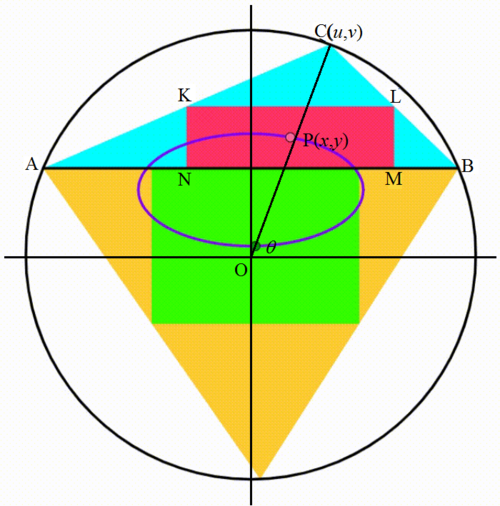Dynamic Geometry: P109
 The diagram shows a black circle. A horizontal yellow chord is drawn creating two circular segments, their respective heights are
4
and
9
. In each circular segment, we inscribe a triangle. In both triangles we inscribe the largest rectangle possible. The center of both rectangles traces a
locus
(purple curve). The area bounded by the purple curve can be expressed as
q
p
π
, where
p
and
q
are coprime positive integers. Find
p
+
q
.
The diagram shows a black circle. A horizontal yellow chord is drawn creating two circular segments, their respective heights are
4
and
9
. In each circular segment, we inscribe a triangle. In both triangles we inscribe the largest rectangle possible. The center of both rectangles traces a
locus
(purple curve). The area bounded by the purple curve can be expressed as
q
p
π
, where
p
and
q
are coprime positive integers. Find
p
+
q
.
The answer is 201.
This section requires Javascript.
You are seeing this because something didn't load right. We suggest you, (a) try
refreshing the page, (b) enabling javascript if it is disabled on your browser and,
finally, (c)
loading the
non-javascript version of this page
. We're sorry about the hassle.
2 solutions
Thank you for posting dear Thanos.

[ Updated to provide a shorter explanation. ] . Let O , the center of the circle, be the origin ( 0 , 0 ) of the x y -plane, the variable triangle be △ A B C (note that △ A B C follows the same equations whether C is on top or at the bottom), O C makes an angle of θ with the x -axis. Referring to the calculations in Dynamic Geometry: P96 Series , the circle has a radius of 6 . 5 , A B = 1 2 , A B is along y = 2 . 5 , and the largest rectangle inscribed by a triangle has a height and breadth half of those of the triangle.
Then C = ( u , v ) = ( 6 . 5 cos θ , 6 . 5 sin θ ) . The height of K L M N , N K = L M = 2 v − 2 . 5 = 2 6 . 5 sin θ − 2 . 5 . Note that △ K L C and △ A B C are similar, then K L = 2 A B = 6 , the x -coordinate of K and N , x K = 2 6 . 5 cos θ − 6 and that of L and M , x L = 2 6 . 5 cos θ + 6 . Let the arbitrary point on the locus or the center of rectangle K L M N be P ( x , y ) . Then the coordinates of P :
⎩ ⎪ ⎨ ⎪ ⎧ x = 2 x K + x L = 4 1 3 cos θ y = 2 L M + 2 . 5 + 2 . 5 = 8 1 3 sin θ + 1 6 3 ⟹ 1 3 4 x = cos θ ⟹ 1 3 8 ( y − 1 6 3 ) = sin θ ⟹ ( 4 1 3 ) 2 x 2 + ( 8 1 3 ) 2 ( y − 1 6 3 ) 2 = 1
Therefore the locus is an ellipse with center at ( 0 , 1 6 3 ) , a major semi-axis a = 4 1 3 , a minor semi-axis b = 8 1 3 , and an area of a b π = 4 1 3 ⋅ 8 1 3 π = 3 2 1 6 9 π . ⟹ p + q = 1 6 9 + 3 2 = 2 0 1 .
Working likewise, we find that the center of the green rectangle traces the rest of the same ellipse.
The semi-axes of the ellipse are a = 4 1 3 and b = 8 1 3 , thus the area of the locus is A = a b π = 4 1 3 ⋅ 8 1 3 ⋅ π = 3 2 1 6 9 π For the answer, p = 1 6 9 , q = 3 2 , thus, p + q = 2 0 1 .